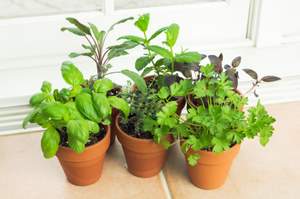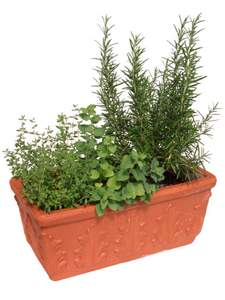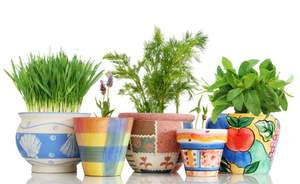|
Growing Herbs Indoors

In this article, we'll show you how to get started growing herbs indoors. Within easy reach to meet your needs, herbs in your home will become helpful friends and soul-pleasing companions. Buying herbs for indoor herb gardensFirst, acquire your herbs. Whichever hemisphere you live in, herbs and their seeds are usually available at any garden centre or plant nursery year-round. The availability of herb seedlings increases as the growing season approaches, in the Spring. Transplant packs of herbs or plants in individual pots are also available in early Spring, but starting plants from seeds is obviously the most economical way of getting herbs to start your Herb Garden. This list of herbs suitable for indoor herb gardens will help you with your selection. A windowsill is all you needEast- or west-facing, a bright window is all you need to provide many herbs with the correct growing conditions they require, which is basically good light, air circulation, regular watering and occasional feeding. Herbs will thrive on their own in an individual pot, or together with other same-requirement plants, such as in a dish garden. Containers for growing herbs indoorsExamples of containers suitable for growing herbs indoors are:
* Clay pots need to be treated with a sealant or a layer of paint applied to the inside surface that will be in contact with the soil and plant roots. This is done in order for the pot to be ‘plant-friendly’ and an adequate vessel for growing your herbs. Clay by its very nature is highly absorbent and will draw into itself much of the water that you are trying to give to your plant. This will result in causing your plant unnecessary stress and you will find that it dries out more frequently than your other herbs planted in ceramic, metal or plastic pots. Recipe for growing herbs indoorsIngredients
Method for planting a single herb plant per containerOnce you have your herbs and the new container in which to make their home, you only need some potting mix, water and a pair of scissors (or secateurs) to start planting herbs in your new indoor Herb Garden. A potting mix in which has already been incorporated the appropriate Micorrhizae is ideal, but any mix that is clean, light, porous and weed/organism-free is quite acceptable. Manufacturers add three other inert substances to their mixes which are very helpful in helping to increase porosity (makes it easy for the roots to grow into) and water-retention (means less watering for you): perlite, vermiculite and water crystals. It’s best to choose these mixes over others which may not have them and are cheaper, but in the long run, also make your herbs’ soil compacted, dry and quite unhealthy for any plant. Your herbs are worth it!
Fill your container three quarters full with the pre-dampened mix and form a shallow hole in the middle with your closed fist. Because it is pre-dampened, the mix will readily absorb water and will gradually give it back to the plant’s roots. Now, gently take out the herb from its pot or punnet and turn it upside down. See all the roots gathered at the bottom? They have taken the initial pot’s form, whether it’s a square or a round container. Take your scissors or secateurs and make a straight, clean and shallow cut on each ‘side’ of the root ball. If it’s a round form, make three cuts equidistant one from the other. If it’s square, make four cuts, one for each side. Start your cut from the bottom and cut upwards, severing all the roots that meet the blades. This is good, as it will encourage new roots to grow and fill in their new home. If you pull and tear at the roots (some people call this ’teasing out’ the roots), more than likely you will kill them. It’s another scientific fact that a root that is torn will die, but one that is cut will grow back multiples of itself and will live. After the roots have been cut, settle the whole herb right side up in the bottom of the shallow hole. Start depositing more potting mix around the root ball and make sure to position the plant’s crown about 4 cm (1.5 in) down from the container’s rim. This means good air circulation for the plant and enough depth for water to collect and slowly seep into the mix when it comes time for watering. Place your newly-planted container out of direct light for a couple of days to help your plants adjust to their new home. After that, you can put it on the windowsill, making sure it gets water when it needs it. Method for planting several herbs together
If you are planting more than one herb in this container, plan to have the taller one in the back, and the smaller ones in the front, planted at least 5 cm (2 in) apart, if the size of the container allows. Gradually deposit the potting mix between the root balls, going to each plant, and then place some into all the sides of the container. After every application, tamp down the plants and potting mix with your palms to insure good contact between the roots and the mix. Do not pack the mix too loosely as this leaves air pockets around the roots. Roots do not grow in air, in fact, they die if exposed to air for too long a time. If your mix is good, it will be porous enough for the roots to get plenty of air through natural openings made by the water as it drains from the top to the bottom of the container. Give your plants a few days out of direct light then put the container on the windowsill, watering as needed. Water requirements of indoor herb gardensWatch your plants as they start living in their new surroundings. How often is the soil drying out? If your home is dry, then this may happen more often than if you live in a humid area. Too much water can kill as well as too little, so get to know your plant’s requirements and treat it accordingly. I have a tested method for determining when my plants need water: I lift the pot. If it’s heavy, usually that means it’s wet and doesn’t need more water. If it’s light and I can see that the surface of the soil is light brown, I know it’s dry and it’s time to water my plant. Water is all-important and cannot be neglected. When growing herbs indoors, your plants are restricted in how they can ‘get’ their necessary water to live, grow and produce their roots, stems, leaves and flowers. After all, they can’t go far in a pot! They rely on you to provide everything for them, so don’t let them down. Be your herb’s best friend, and yes, it’s ok to talk to your herbs. Test plants given much care and concern over their welfare have been proven in scientific experiments to grow healthier and stronger than those test subjects which were ‘emotionally’ neglected. There you go: you have a new indoor herb garden to enjoy! As you can see, growing herbs indoors is an achievable and worthwhile project. By Raymonde Savoie Johnson Need help selecting plants for growing herbs indoors? Here's a list of herbs for indoor herb gardens. Back to Growing Herbs from Growing Herbs Indoors
Back to Healthy Eating Guide home from Growing Herbs Indoors
|
Are you as healthy as you can be?
Take action to lift your energy and vitality levels beyond recognition.
Focus on
building healthy eating habits for just one month with
Veg Up and you’ll enjoy the effects for years. You will amaze yourself when you see how much more you can achieve.
More Growing Raw
Newsletter
Be sure to subscribe to "More Growing Raw" newsletter to receive monthly healthy eating tips, Growing Raw news and updates.
Most Popular Articles
- Green Smoothie Health
- Raw Food Health Levels
- Growing Vegetables in Containers
- Healthy Eating Plans
- List of Healthy Food to Always Eat Organic
- Growing a Vegetable Garden in a Polytunnel
- All Natural Detox Diet
Does your body need a fresh start?
Brighten up with all natural detox routines that give your body a cleansing push towards healthier patterns.
Learn how to
detoxify your body naturally. Your body is smart enough to clean itself without expensive detox pills and potions.









